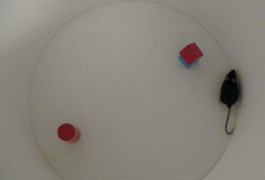THIS ARTICLE IS MORE THAN FIVE YEARS OLD
This article is more than five years old. Autism research — and science in general — is constantly evolving, so older articles may contain information or theories that have been reevaluated since their original publication date.

Coping trouble: Mice that lack FKBP12 in their brains late in development have difficulty learning new ways to solve a task.
The absence of a protein involved in a prominent cancer pathway leads to repetitive behaviors and learning deficits in mice, creating a viable model for autism research, according to a study published last week in Neuron 1.
The protein, FKBP12, serves as a receptor for rapamycin, a cancer drug that has shown promise as a potential therapy for autism. In the brain, the protein is also important for synaptic plasticity ― the ability of neurons to change the strength of their connections ― which is increasingly seen as important in autism2.
Researchers at New York University eliminated FKBP12 from the brains of young mice late in their development. When the mice are subjected to a battery of learning and memory tests, they seem to learn a task well one way, but have trouble learning a different variation of the same task.
“Even though the brain is probably developing more or less normally for the first one to two weeks, we were getting these behaviors that would be consistent with autism and [obsessive-compulsive behavior],” says lead author Eric Klann, a professor at New York Universityʼs Center for Neural Science.
For example, researchers trained the mice to locate an escape platform on a Y-shaped water maze. During the initial training, the knockout mice were just as good at locating the platform as were controls. But when the location of the escape changed, the mutant mice required about 25 percent more trials to find the new escape.
The researchers also found that, in a task designed to assess repetitive and stereotypic behaviors, the mutant mice dig and bury many more marbles than do the controls.
“I think this mouse will be a valuable way to understand the basis of repetitive and perseverative behaviors,” says Raymond Kelleher, an assistant professor of neurology at Harvard Medical School who was not involved with the study.
The mTOR link:
When FKBP12 binds rapamycin, the complex inhibits signaling of the rapamycin target mTOR, a protein with many functions, including protein synthesis and synaptic plasticity.

ba44544d-7280-9a94-e9cd-40254ccd57b0.jpg
Wiped out: FKBP12 is expressed in the hippocampus of control mice (left) but not in mice with the conditional deletion (right).
Itʼs not entirely surprising that mice lacking a protein that inhibits mTOR show autism-like features. Mutations in other molecules that dampen mTOR signaling, such as Tuberous Sclerosis Complex 1 and 2 and PTEN, have also been implicated in autism and some cancers.
Using electrophysiology to stimulate and measure the neuronal firing, Klannʼs group found that the mutant mice also appear to have enhanced levels of one form of synaptic plasticity called late-phase long-term potentiation, a lasting increase in the strength of the connection between two neighboring neurons.
This increase in strength requires the synthesis of new proteins in synapses, the links between the neurons. The study supports the idea that disruptions in synaptic protein synthesis may underlie some aspects of autism, Kelleher says.
Because the mice have normal levels of FKBP12 in early development, the findings suggest that some autism-like features may not be genetically and environmentally predetermined in the womb, Klann says.
“Some of the behaviors could occur because you donʼt have this signaling pathway functioning normally in the adult,” he says.
Klannʼs group is trying to determine whether the miceʼs autism-like features are linked to specific brain regions or circuits. The researchers also plan to inhibit mTOR or its downstream effectors to try to reverse some of the behaviors.
By joining the discussion, you agree to our privacy policy.